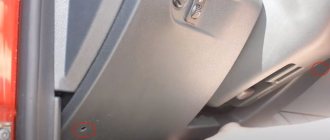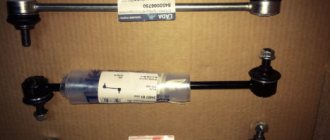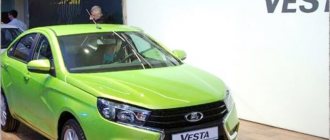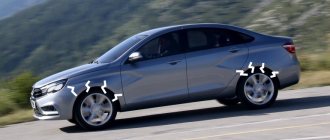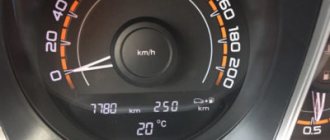The Lada Vesta model became the founder of a new era in the domestic automotive industry, when cars of Russian origin reach a fundamentally new quality level. You can’t argue here, since the new product has a fast-paced exterior design and a progressive interior, which includes a wide range of modern electronic comfort and safety systems.
Let us turn our attention to the body of the Lada Vesta, because it is the most expensive part in the car. How will this element behave in harsh climatic conditions, will the body rot? Is the body galvanized? There are a lot of questions. To increase the resistance of the body to the onslaught of external factors, manufacturers galvanize it. The main question: is the body of the LADA Vesta galvanized? Let's try to find out.
LADA VESTA body – galvanized or not? Subtleties of painting and protection
A lot of controversy has been caused about the modern AVTOVAZ car, which is VESTA. Many do not believe our automobile industry and say that “modern generation” is nothing more than a continuation of the “folk” GRANT, KALINA, PRIOR on the one hand. If we put aside everything else (technical and design), opponents of the brand, often entering into disputes, bring up the following facts - “ it will rot in a couple of years if not treated correctly ”! However, the manufacturer gives a guarantee “for 6 years” specifically on the body, that there will be no signs of through corrosion. And now the concept of “galvanization” begins to blow, opponents will again say that it simply isn’t there (this is a LADA, NOT a MERCEDES), others say that it is there and that the parts are reliably protected. So where is the truth? Today we’ll sort it out whether it’s there or not...
Starting the article, I would like to quote the words of one “mega-expert” from a specialized forum (I will not rewrite it verbatim), but this is the meaning. There used to be VAZ 2101s - the metal was of high quality, that’s why it didn’t rot! But now I don’t understand why, that’s why they cover it with all sorts of crap – “anti-corrosion”, “galvanization” and so on. I would like to immediately object to him, these methods are responses to modern road conditions. Previously, when “KOPEYKA” appeared, there were very few cars, I remember the winters - the snow from the roads was practically not cleared (only the main highways), there were no reagents. And what now - the roads, even at minus 10, are somehow wet, all because they are simply covered in reagents that corrode snow and ice, respectively, the body, paint and even tires (and what can I say, sometimes even boots don’t work for the season). Under such conditions, the entire “2101” would have rotted in a couple of years! So they protect modern cars, in a modern way, excuse the tautology.
Galvanized sheets are not used during assembly
Dimensions of the Lada Vesta car in comparison with its foreign counterpart. Lada Vesta width
Even a non-specialist can see whether the body of the Lada Vesta shown in the photo is galvanized.
The sheets were cut, bent, welded
Here we see ordinary steel, not coated with anything. Galvanized steel is not used, for which there are reasons:
- Welding only joins uncoated materials;
- It is not clear on which machines to cut and further process galvanized sheets;
- A sheet of steel, galvanized even on one side, will cost 3 times more than regular sheet metal.
A zinc layer that is too thick (20-30 microns) will crack quickly. But VAZ is doing just fine with this parameter.
There are a lot of articles about cold galvanizing at VAZ, and I believed that it is not a layer of zinc that is applied, but a zinc-primer mixture, after which the primer is not applied. But the author writes that a layer of zinc is applied, then a primer in the bath. Why prime again? Why can’t the inside be coated right away or is it expensive?
At first I was also perplexed: they galvanize, but only halfway. For what? And then I remembered: in our country everything comes at some point, good beginnings end in death...
If you coat metal sheets with zinc on both sides, then it cannot be further processed by pressure or bending (it breaks). In the West, galvanization is not used at all.
Yeah, what are the Germans doing then? Almost all of their models are galvanized.
A six-year warranty is a very good period in any case. These cars certainly won’t rust and rot like Nivas.
yeah but it's from through corrosion
There’s no need to spread rot on NIVA, I have a 5-year-old Niva, manufactured in 2011, and it doesn’t think about rotting.
The manufacturer has already galvanized its models. Galvanizing Vesta should improve strength. Well, yes, in any case, a long guarantee.
The main thing is that it exists. Of course, I would like it to be of better quality, but in comparison with the price, this is a very real way out of the situation aimed at reducing the cost of the final product.
a ton of metal is 10,000 rubles three times more expensive = 30,000 rubles, and the car drives quietly and does not stand under a fence!
Renault Logan is galvanized using the electroplating method in an electrolyte bath. Is the Lada Vesta primed with zinc metal? After all, this is not full-fledged galvanization, which is our brains! The warranty on the body is 6 years, and the Koreans have 8 years (with galvanization). zinc metal is not full-fledged galvanization
I asked the question whether the Lada X-ray is galvanized: Some car enthusiasts may be extremely interested in how the car body is galvanized. The process can be described quite simply. The part to be processed (already in finished form, stamped on the assembly line) is immersed in a heat-resistant bath filled with molten zinc. The melting point of zinc is over 400 degrees Celsius, so the entire process is carried out automatically, which ensures high accuracy and quality of processing. Due to the high temperature, a thin layer of galvanizing is partially mixed with the molecules of the metal from which the part is made, thereby ensuring strong adhesion between the part and the shell, which protects it from corrosion. This procedure allows you to completely deprive the workpiece of areas that are not protected from rust. Material from the site: ixraylada.ru Who to believe?
An acquaintance bought a Vesta, drove it down a dirt road to the village, and all 4 doors jammed, he took it to a service center and quickly straightened the body and sold it to the Vesta and draw your own conclusions about what kind of car it is.
Either you or your friend have a rich imagination
I doubt that this is true. I drove the rusty 21083 along the village road, and nothing stuck. Maybe you're talking about the Daewoo Nexia?
This figure filled the entire Internet with this opus, apparently they paid well. Relying on consumer ignorance. There is not a word of truth in the article, it is some kind of ignorant nonsense in reality. All manufacturers weld the body from metal, galvanized on both sides. The strip is galvanized in a metallurgical plant either by immersion in a hot melt or galvanically in a solution. All front parts, partly the bottom and part of the brackets are made of this steel. Most manufacturers make the roof non-galvanized, because it makes no sense and is expensive. This is the same on Vesta, which is why there is a 6-year warranty, which previous models could not have had. Plus, Vesta has three times more protection for seams with mastic and a new technology for protecting cavities with wax. More than two years have passed, but try to find reviews that Vesta is rotting - no. I wonder if this review will pass? I wouldn’t be surprised if all these sites are from the same “manufacturer”.
Georgy, take two galvanized parts and weld them. Then write how it turned out
If you do as you say, then the welding areas are then galvanized again? So why the hell then boil galvanized metal, when you can then galvanize everything at once.
Where it rusts
There are problem areas on the body of my car. For example, on the front fender and in other places there are abrasions and chips down to the metal, but there is no rust yet. Under the hood I looked at the bolted connections, the joints, so far everything is in order, not rusting.
I found a rusty part under the hood on the right side as the car was moving.
I also found a place with metal corrosion. This is the bottom of the front left door from the inside.
Such body defects can only be found on internal surfaces. This is due to galvanizing technology. They will have to be treated with something, otherwise in 2-3 years there will be through holes. This is how we treat Lada Vesta at the factory. My car is only 3 years old. Surely the body was galvanized poorly and the primer was poorly applied.
Share information about the situation with corrosion on your cars.
Subtleties of galvanization
Many people do not believe in the Russian automobile industry; they say that the Lada Vesta is a regular continuation of the Priora, Kalina and Granta. If we take away the design and technical part, Vesta’s opponents often argue and say that it will rot in 2 years without additional treatment. But AvtoVAZ guarantees body protection for 6 years.
Haters say that there is no galvanization on the body, optimists claim that, on the contrary, the parts have reliable protection. So is the body of the Lada Vesta actually galvanized?
One newly minted expert argued that previously the “penny” was made of high-quality metal, so it did not rust. And now it is allegedly not clear what kind of iron it is, which is why they are coming up with different protective coatings.
I want to say right away that these methods are used in connection with road conditions. When VAZ-2101 cars drove on the roads, there were few cars. The snow on the roads was hardly cleared, no chemicals were used. Now, even at -10, you can see puddles on the road because they poured chemicals that corrode the ice.
“Kopeyka” under such conditions would have rotted in 2 years. Therefore, modern cars are better protected.
Is Vesta galvanized?
There is a good layer of zinc on it, but this is not the standard of protection. All external surfaces of parts have been processed - body pillars, trunk lid, hood, roof, doors. However, there is no such zinc protection on the inside of the body. Only those elements that come into contact with the external environment are protected.
Types of technologies
The method of galvanizing the body from AvtoVAZ is budgetary and far from being a quality standard. A special powder is applied by spraying. How can zinc protect iron? It is a non-ferrous metal and is the first to corrode, since its potential is more negative compared to steel. Even if the zinc is damaged or destroyed, the protection continues to work.
The thicker the zinc coating, the longer the car body will not rust.
For applying protective zinc powder, 4 types of technology have been created:
- Hot. Used by Volvo, Porsche and other expensive brands.
- Galvanic. Used by Toyota, Mercedes, BMW, Kia, Mitsubishi, Honda and others.
- Zinc metal. This is a two-layer plastic coating. Used by the Korean automaker Kia on cars ranging from class “C” and above.
- Cold. The method is similar to regular painting. A powdery substance containing zinc is sprayed onto the body. The technology is used by many automakers - AvtoVAZ, Toyota, Hyundai, Kia, Chevrolet.
Technologies are listed in descending order of protection reliability. The Lada Vesta car is galvanized using the latest method, so the zinc layer requires additional reinforcement.
The galvanized metal of the Lada Vesta will quickly begin to rust if it is not protected. Moreover, there is no zinc inside the cabin. Therefore, a two-layer primer using cataphoresis technology is used. The body is immersed in a bath of chemical reagents, in which soil is deposited on the surface of the iron.
At the next stage, paint and varnish are applied to the primer. The result is a multi-layer coating consisting of zinc, two layers of primer, colored enamel and varnish. In addition to the Lada Vesta, many past VAZ models are also protected by cold galvanizing and cataphoretic primer.
Body galvanizing technology is the most effective. During this process, the car body is dipped into a bath filled with molten zinc. The temperature of the solution ranges from 445-460 °C. However, this method is also the most expensive. In the West, automakers galvanize about 95% of the bodies of their models.
Painting the Lada body
When painting, we get the following “pie”, the thickness of the body metal is 0.6-0.8 mm:
- Zinc, first layer;
- Cataphoretic primer;
- Polyester cataphoretic primer - second layer;
- Enamel;
- Varnish.
The question of whether the Lada Vesta has reliable paintwork can be answered. A galvanized body in combination with high-quality anti-corrosion primer, enamel and varnish allows you to create a coating whose thickness is 150 microns.
This technology prevents metal parts of the car from rusting. Therefore, AvtoVAZ has established a 6-year warranty on the Lada Vesta against through corrosion.
The body of the Lada Vesta Lada Vesta with a galvanized body has only the outer side coated, the inner surface is simply covered with primer and painted.
This is due to the fact that the outer surface is subject to mechanical damage from sand and gravel from oncoming traffic and car wheels. As a result, chips and scratches appear on the body. The inner surface is not subject to any mechanical damage, so there is no need to galvanize additionally. Anti-noise protection is applied to the bottom of Vesta between layers of cataphoretic soil.
The bottom and sills of Vesta are treated with anti-gravel coating. No additional anti-corrosion treatment is required. If necessary, you can apply anti-corrosion protection after two years, and even then if you plan to operate the car for 10 years.
Answering the consumer’s question whether the Lada body is galvanized or not, one can give a positive answer: yes, the Vesta body is galvanized. And this does not depend on where the car is assembled in Tolyatti or Izhevsk. To be fair, it should be noted that AvtoVAZ uses the cheapest type of galvanization.
It performs galvanizing using zinc-filled paint, i.e. Fine zinc dust has been added to the paint. This is not the high-quality hot zinc coating of a car, which is used by foreign automakers, but the use of this technology gives good results.
About myths
Almost everything has been clarified, but again, many skeptics who are accustomed to saying that there is nothing good at AVTOVAZ can put forward some theses:
- Foreign cars are made from fully galvanized sheets. Perhaps someone does this (in their barn in particular), but in most industries around the world such sheets are not used. They are soft (do not have the required strength), do not weld well (easily burn through), the cost of the body will go through the roof
- The cold method is used only at AVTOVAZ. This is also not true, for example Chevrolet, KIA, HYUNDAI, TOYOTA, MITSUBISHI use it on many of their cars (even if they are of a budget class, but still). For example, CRUZE is covered worse than VESTA, it does not have sill treatment and some front power struts
- The layer is so thick that it falls off. I really don’t understand who comes up with this idea. If you check with a micrometer, it turns out: the roof is about 105-125 microns, the doors are about 145 microns, the wings are 140 microns, the hood is 110 microns, the trunk lid is 120 microns. This is a complete “pie” that is applied to the steel. It is approximately the same as on many foreign cars of this class and nothing falls off on anyone.
- Only VESTA is processed; other VAZs are not treated! This is again a myth. Galvanization is applied to the following models: GRANTA (LIFTBACK) - fifth door, fenders (here is the bare minimum of galvanizing), KALINA2 - all external surfaces, except the hood, roof, front and rear side members (fender liners are needed here), PRIORA (since 2009) - everything except the roof, hood. X-RAY - everything outside, except the roof, VESTA - the entire external surface, with the bottom, sills and arches additionally treated with anti-gravel.
As you can see, a lot of things are far-fetched, now I’m providing you with a video version, let’s take a look.
I’ll end with this, I think it was useful, read our AUTOBLOG, subscribe to the channel.
(13 votes, average: 4.00 out of 5)
Today, all leading car manufacturers are increasing the reliability and durability of their products, including galvanizing their bodies. This technology significantly increases the level of body protection from rust. Accordingly, the car becomes more durable. The Volzhsky Automobile Plant also tries to protect its products from corrosion. However, the introduction of such technologies at the enterprise began relatively recently.
Body thickness (paintwork) of LADA Vesta
During the production process, the manufacturer applies four layers to a sheet of metal: varnish, paint, primer and zinc. The first three are simply called by the abbreviation LKP. When buying a car, you must always have information about the thickness of the paintwork and zinc, because the survivability of the body and, consequently, its service life depend on these indicators.
As for the LADA Vesta car, these indicators are as follows:
- trunk lid – 125 microns;
- doors – 140 microns;
- roof – up to 128 microns;
- hood – 104 microns;
- the wheel arch wings have the highest protection – up to 144 microns.
As for the thickness of zinc, the figure here is quite low - only 8 microns and this is in the most well-protected places. And yet, such a thickness is quite enough for the body to resist corrosion for at least 5 years in the worst operating conditions.
To slightly compare the degree of corrosion protection of LADA Vesta with other cars, you should know that most modern cars have a layer of 100 to 150 microns. Thus, we see that a domestically produced car fully meets international standards.
What to look for
Every year, technologies are improved, and the guarantee for body protection against rust increases, and AvtoVAZ is no exception (the thickness of Vesta’s paintwork is at the level of its competitors, 100-150 microns). Pay more attention to the presence of this guarantee than to dubious information about body galvanization from the media and advertising.
At the moment, AvtoVAZ provides a 6-year . Depending on the operating conditions of the vehicle and the quality of the body treatment with anti-corrosion agents, its service life can vary greatly (see survey). If rust appears during the warranty period, do not hesitate to contact your dealer.
How do you evaluate the anti-corrosion treatment of Lada car bodies? Is it necessary to additionally treat weak points or is the factory version sufficient? Let us remind you that you can get acquainted in more detail with modern AvtoVAZ cars by content in the context of models (Vesta, Granta, Priora, Kalina, Largus, Niva 4x4 and XRAY). The VK survey is being conducted among Vesta owners.
AvtoVAZ promises
Representatives of the plant more than once, during the preparation of the new sedan for production, said that it would be assembled at a fundamentally new level. This also concerned the eternal problems of domestic cars - weak paintwork and the rapid occurrence of corrosion. Everyone remembers how the same Priors began to bloom with saffron milk caps within six months to a year after purchase! For modern cars this is bad manners. It is not surprising that Lada owners, as well as those who were just trying to buy one, demanded the release of cars with galvanized bodies.
Lada Vesta bodies are being prepared for painting at a completely different level.
Knowing how many complaints were pouring in about their products, the leaders of the Russian concern hastened to assure the public that this would not happen to Vesta. In addition, it was directly stated that VAZ is ready to give a 5-year warranty on bodies of its production. Of course, in comparison with German or Swedish models, whose metal warranty lasts 12-15, or even 20 years, such measures looked modest. However, many did not even want to believe this.
So what happened in the end?
What size is the body of the Lada Vesta
It’s worth starting with the most essential. The body dimensions of the Lada Vesta are an important parameter that determines the car’s maneuverability in the city, its stability and controllability. Body size and type are the first things to consider when considering buying a car. The varieties of this brand have different sizes. So, a station wagon in any configuration has parameters of 4410 mm x 1764 mm x 1512 mm, where the first number is the length, the second is the width, and the third is the height. The Lada Vesta sedan will have dimensions of 4410 mm x 1764 mm x 1497 mm. Lada Vesta SV has parameters of 4410 mm x 1764 mm x 1508 mm, and Lada Vesta SV Cross is the largest car of all - 4424 mm x 1785 mm x 1537 mm.



